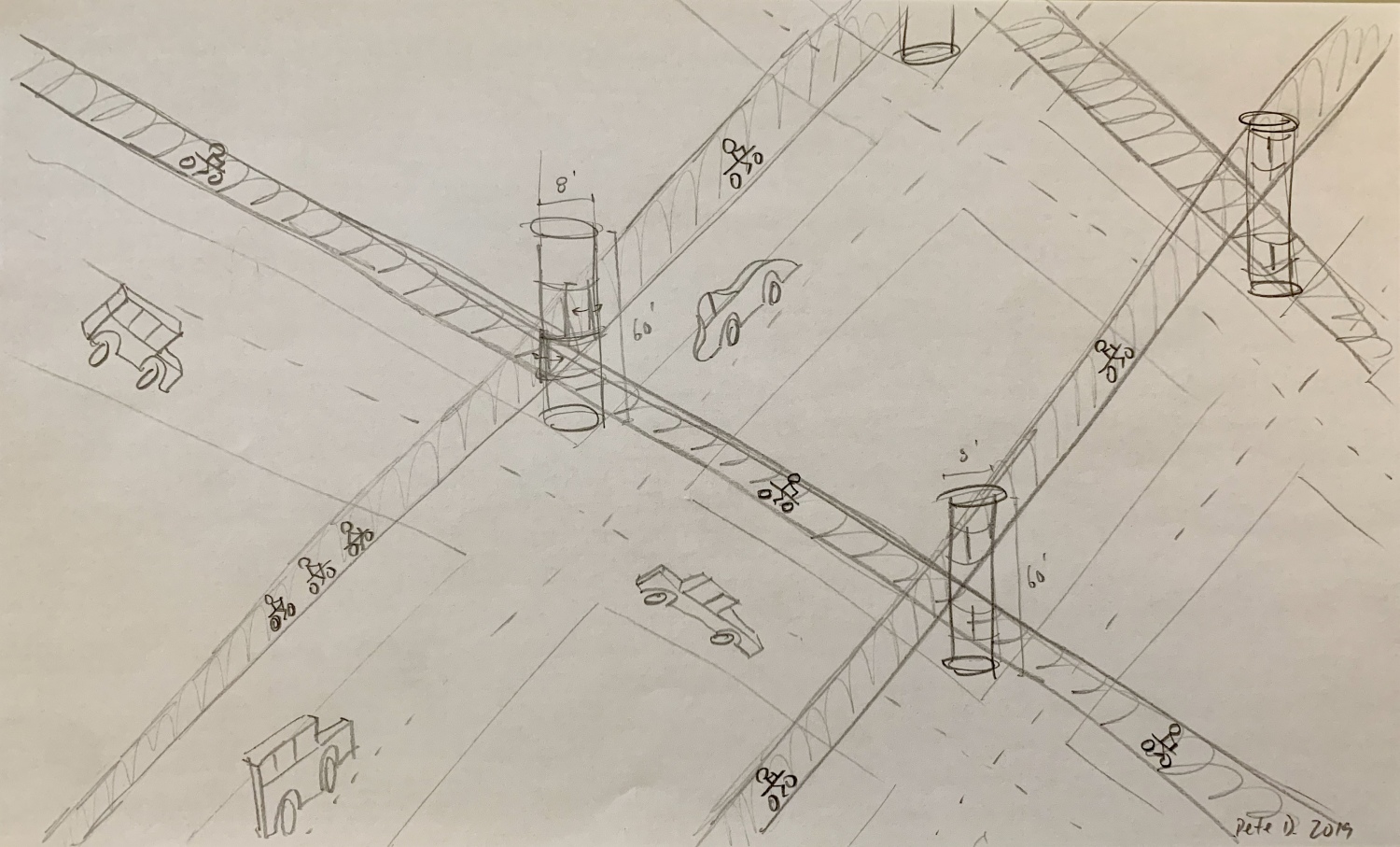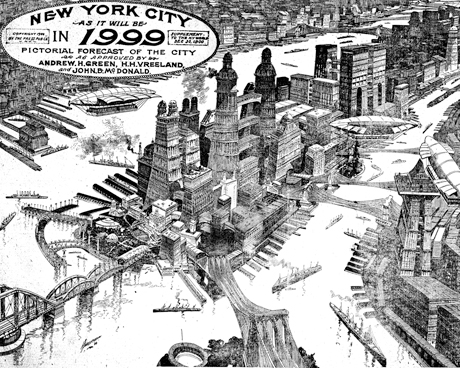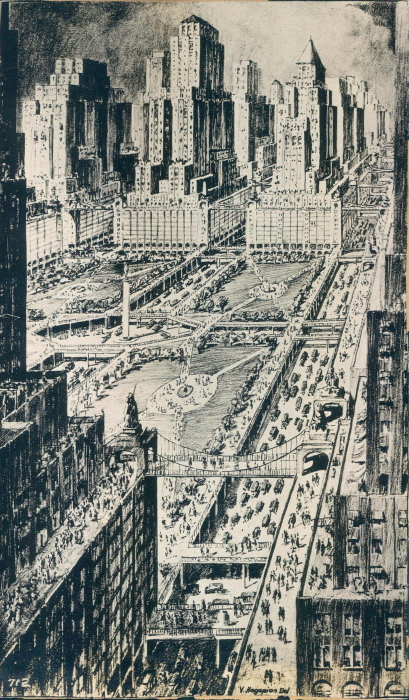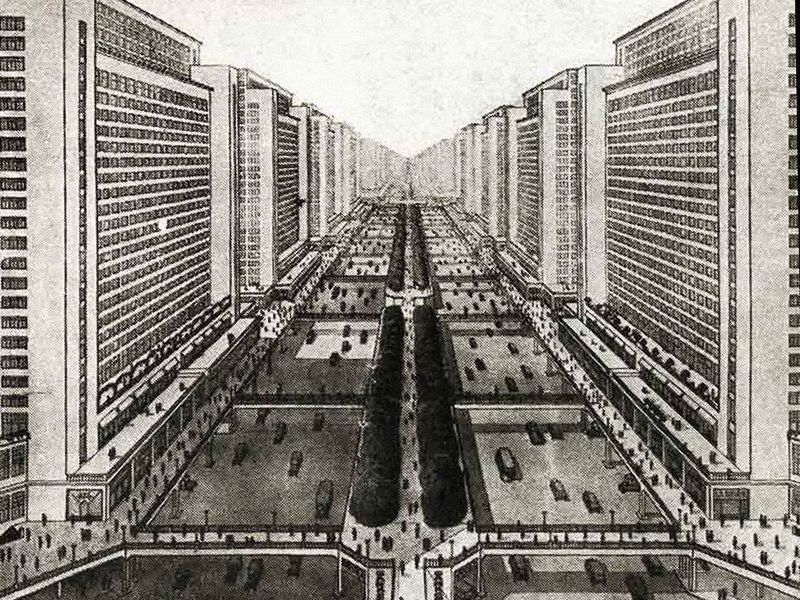On the subject of segregated bicycle lanes, instead of quite the same long-winded “analysis” this time,i let’s head straight for the meat ‘n’ pertaters… the drawings.ii Say hello to SkyTube™, coming next century to a city near you!!

Le Corbusier and other futurists of yesteryear imagined a world where cities (particularly NYC) boasted dozens of interconnected layers of Leviathan proportions (and monstrous shadows).iii Futurists of more recent decades have scarcely imagined more than what they saw in The Matrix but let’s not allow the recently fashionable dystopianists have all the fun! So imagine, if you will, the submerged glass tube at the aquarium in Barcelonaiv but fully encircled, so the semi-circular glass enclosures will be enlarged in diameter from 6′ (1.8m) to 20′ (6.1m), and then suspended in mid-air. With modular construction in standardised segments of 40′ (12.2m), these tubular assemblies will be simple to replace for repairs. Repairs will be conducted overnight by swapping out individual segments and replacing them on-the-spot, eliminating disruption to regular daytime users.v The lowest tubular modules on the grid will be raised 20′ (6.1m) off the ground from their base to allow of continuous visibility of first two floors of neighbouring building atria as well as for unhindered access of semi trucks and trailers at intersections, very much like the Xiamen “Bike Skyway” loop designed by Danish firm DISSING+WEITLING and also a bit like Sir Norman Foster’s proposed SkyCycle from 2013, not to mention BMW’s E³ Way from 2017. The difference from those examples, however, is that SkyTube™ will be covered, insulated, conditioned,vi all-weather ready, and modular.
The tubes themselves will be enveloped in radially-curved double-pane R18 vacuum-insulated glass (VIG)vii composed of two continuous sheets of 12mm thick glass per modular section, with the exterior surface (surface #1) coated in Clearplex.viii Structural silicone (eg. Dow 795) will be used at the intersection of the modular tubes to seal them together. This silicone product is durable, breathable, waterproof, also easily cut when modular segments need to be replaced, and doesn’t impinge upon sightlines from the interior. Within each SkyTube™ channel, as you can see, bicycle and pedestrian traffic will both be accommodated. Trees and shrubs will also be an integral part of the design, being irrigated, drained, and providing year-round psychosocial benefits to users.
The elevators up to the platform levels will be located at each major intersection. These elevators double as structural supports and triple as water/air connections for SkyTube™. There will be three elevator floors : ground floor, east-west SkyTube™ floor, and north-south Skytube™ floor.ix
This design is free to be “copied” and now exists in the public domain.
Are there any questions ?
___ ___ ___
- Persuasive to city officials though it was…↩
- Why no colour ? Why no pencil crayons ? As an homage to the black-and-white ink drawings of a century ago, I suppose. For all our great-grandchildren will know, colour copying came and went leaving nary a trace. ↩
- Eg.
- I tell you it was a sight to behold when I first passed through it in 1996. The Barcelona Aquarium had just opened the year before, in 1995, and it had all the *¡WOW!* factor an impressionable kid could dream of. That, ladies and gentleman, is how you design a science centre, children’s museum, or aquarium. Make it memorable, make it interactive, and make it more than just gawking emptily at screens and stabbing at more buttons. If only the Telus World of Science (née Edmonton Space and Science Centre, designed by none other than Douglas Cardinal) could figure out the interactive exhibition formula the way that Spark in Calgary and Science World in Vancouver have! ↩
- You can also imagine that the machines used to pick-up SkyTube™ modules will look like log pickers used in forestry, but of course we’ll have electric ones because they’re quieter for nighttime work. These SkyTubePickers™ also won’t have back-up beepers for the same reason.
I swear there was a Baudelaire poem about urban noise pollution but I can’t seem to find it now, so to quote Ari Gold, silence is fucking golden! ↩
- Air handling (including heating, cooling, and purification) will be an integral part of SkyTube™ because even dieselgate hasn’t cured Albertans of their obsession with “rolling coal” even if, blessedly, truck nuts seem to be a thing of the past (for now). The same air quality concerns are true in most highly developed/developing Asian cities with the notable exception of Singapore, and this will likely still be true a century hence. ↩
- VIGs greatly reduce thermal transmission compared to a conventional insulated glass unit (IGU) by creating a non-conductive vacuum in the “air” space between two of the glass panes (lites). Whereas lites are normally separated by a 13-16mm air space filled with argon or krypton, VIGs have only 0.25mm space between lites, between which a vacuum is created and a grid matrix of 0.25mm wide stainless steel pillars are installed to prevent the lites from sucking into each other (see spacing and details in diagram). ↩
- Clearplex solves the problem of rock chips, which, as we know, are a pain in the pitouey and all too common in northern climates. ↩
- This system obviously works best on cities planned on a grid. ↩




